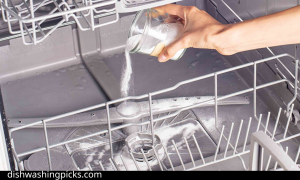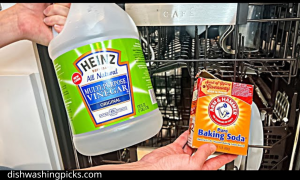Have you ever opened your dishwasher, expecting a burst of fresh, clean air, only to be greeted by an unpleasant, lingering odor? It’s a scenario that many of us have encountered at one time or another. But before you go running out to buy expensive deodorizing agents, consider this there’s a simple, cost-effective solution right in your
We’ll walk you through how to deodorize dishwasher with baking soda. It’s a simple and effective solution that not only tackles the odor issue but also promotes a clean and hygienic environment for your kitchenware. So, let’s embark on this journey to a fresher, more pleasant dishwasher, where every cycle ends with a breath of clean, odor-free air.
How to deodorize dishwasher with baking soda
Let’s dive right into the practical steps to how to deodorize dishwasher with baking soda. It’s a simple and cost-effective method that’ll leave your dishwasher smelling fresh and your dishes free from any unwanted odors:
Cleaning the Filter

Start by pulling out the bottom rack of your dishwasher.
Beneath it, you’ll find the filter – a common hiding place for food particles and odors.
If it’s particularly gunky, you can scrub it gently with a brush. A clean filter is the first line of defense against dishwasher odors.
Wiping Down the Interior
Next, grab a damp cloth or sponge. Dip it in a mixture of warm water and a little dish soap, and then give the interior of your dishwasher a good wipe-down.
Pay special attention to the door gasket and the walls where grime and food residue tend to accumulate.
This quick cleaning will make a world of difference in combating any lingering smells. These are among the steps to deodorize dishwasher with baking soda.
Best drinking glasses for dishwasher (Best 7 suggestions)

Now, the magic of baking soda comes into play.
This odor-absorbing wonder will work its charm as your dishwasher runs its next cycle.
No need to stress about being precise; just spread it around evenly.
Running a Cleaning Cycle
Before you close the dishwasher, make sure it’s empty of dishes. Now, set it to a hot water cycle.
The heat will help in activating the baking soda and break down any lingering odors.
Start the cycle and let your dishwasher work its magic.
Once the cycle is complete, open your dishwasher, and inhale the sweet scent of success.
You’ll notice the absence of that unpleasant odor, replaced by a neutral, clean freshness.
There you have it, a simple yet effective way to deodorize your dishwasher with baking soda.
No need for fancy deodorizers or chemicals – just a touch of care, and a bit of baking soda.
Explain how to maintain a fresh-smelling dishwasher
Keeping your dishwasher smelling fresh is just as important as deodorizing it when unpleasant odors crop up. With a bit of regular maintenance, you can ensure your dishwasher remains a haven of clean and odor-free dishes. Here’s how to maintain that fresh-smelling allure:
Regular Cleaning Routine
Just as how to deodorize dishwasher with baking soda, it’s essential to clean your dishwasher periodically.
Every month or so, run an empty cycle with a dishwasher cleaner. These cleaners help in removing buildup, mineral deposits, and any potential odors.
Read the label on your chosen cleaner for specific instructions and dosages.
Best and most effective dishwasher detergent for grease ever
Rinse Dishes Thoroughly
Before loading your dishwasher, scrape off any excess food particles from your dishes.
A quick rinse under the tap can help in preventing food debris from accumulating in the filter or along the dishwasher’s interior, which can lead to odor issues over time.
Maintain the Filter
After learning how to deodorize your dishwasher using baking soda
Must start -Maintain the Filter-, regularly pull it out and give it a rinse under warm water.
If it’s clogged, a gentle scrub with a brush can help. A clean filter ensures that your dishwasher operates efficiently and doesn’t harbor unwanted odors.
Run a Vinegar Rinse
Every few months, instead of detergent, place a cup of white vinegar in the top rack of your dishwasher and run a full cycle. Vinegar helps break down mineral deposits and rids your dishwasher of any lingering odors.
It’s like a spa day for your kitchen appliance.
Leave the Door Ajar
After you’ve unloaded your clean dishes, leave the dishwasher door ajar for a little while to allow any moisture to escape.
This prevents the growth of mold and mildew, which can be sources of unpleasant odors.
Check Seals and Gaskets
A damaged gasket can allow moisture to escape and cause odors to develop.
If you spot any issues, it may be time for a replacement. Or you know how to deodorize dishwasher with baking soda which we mentioned.
By following these simple maintenance steps, you’ll keep your dishwasher in tip-top shape, ensuring that it continues to deliver spotlessly clean and fresh-smelling dishes.
Your kitchen will be a pleasant place to be, with no unwelcome surprises when you open that dishwasher door.
Choosing the Best Air Gap for Dishwasher
Provide tips on preventing future odor issues
Let’s talk about how to prevent those pesky odors from making a return appearance. It’s all about a little bit of regular care and some thoughtful practices. Here are some tips to help you maintain a consistently odor-free dishwasher:
- Rinse Plates Before Loading This simple step prevents large food particles from settling in your dishwasher and causing odor issues.
- Run Hot Water Before Starting a Cycle Before launching a cleaning cycle, run your kitchen faucet until the water is hot.
Where does my dishwasher drain into?
Your dishwasher typically drains into your home’s wastewater or drain system. The specific location where the dishwasher’s drain hose is connected can vary, but it is usually one of the following:
Garbage Disposal Unit
If your kitchen sink has a garbage disposal unit, the dishwasher’s drain hose is often connected to a nipple on the side or top of the disposal. This allows food particles and wastewater from the dishwasher to be ground up and carried away with the rest of the sink’s wastewater.
Air Gap
In some cases, especially in areas with plumbing codes that require it, the dishwasher’s drain hose is connected to an air gap fitting mounted on the sink or countertop. The air gap provides an extra layer of protection against wastewater backflow from the drain system into the dishwasher. From the air gap, the wastewater is then directed into the drain pipe or disposal.
Sink Drain Pipe
If there is no garbage disposal or air gap, the dishwasher’s drain hose may be connected directly to the sink’s drain pipe, often through a high-loop or an anti-siphon device. This arrangement ensures that the wastewater from the dishwasher flows into the drain system without backflow.
Dishwasher Drain Line
In some homes, there may be a separate dishwasher drain line that connects directly to the home’s drain system. This is less common but can be found in certain older or custom plumbing setups.
Regardless of the specific configuration, the goal is to ensure that the wastewater from the dishwasher flows into the home’s wastewater or sewage system, preventing any contamination or cross-connection between the dishwasher and the potable water supply. The dishwasher’s drain hose and connection method should comply with local plumbing codes to ensure proper drainage and safety.
Should the dishwasher drain before or after disposal?
The order of draining for a dishwasher and garbage disposal can vary depending on the specific plumbing setup. There are generally two common configurations:
Dishwasher Drains Before Disposal:
In this setup, the dishwasher’s drain hose is typically connected to a nipple or inlet on the side or top of the garbage disposal unit. This configuration allows the dishwasher to drain into the garbage disposal.
The advantage of this setup is that any food particles or debris from the dishwasher can be ground up by the disposal, helping to prevent clogs in the drain system.
However, it’s essential to ensure that the dishwasher’s drain hose is connected properly and securely to the garbage disposal to prevent leaks and backflow.
Dishwasher Drains After Disposal:
In some cases, especially in older homes or specific plumbing setups, the dishwasher’s drain hose may be connected to the sink’s drain pipe after the garbage disposal.
This arrangement allows the dishwasher to drain directly into the sink drain system, which then flows into the disposal.
The disposal unit is still responsible for grinding up any food particles that enter it, but the dishwasher wastewater first goes into the sink drain.
The choice of which setup to use depends on the existing plumbing in your kitchen and local building codes. Both configurations can work effectively as long as they are properly installed and in compliance with plumbing regulations. If you’re not sure which configuration is appropriate for your situation, it’s a good idea to consult with a professional plumber to ensure proper installation and compliance with local codes.
In conclusion
Your dishwasher, that unsung hero of your kitchen, need not be plagued by unpleasant odors. With a bit of baking soda, some simple maintenance, and thoughtful practices, you can ensure that it consistently provides you with not just sparkling clean dishes but a welcoming breath of fresh air every time you open its door.
The steps we’ve discussed on how to deodorize dishwasher with baking soda, from deodorizing with baking soda to regular cleaning routines and prevention measures, are your ticket to a kitchen that feels clean, hygienic, and odor-free.

